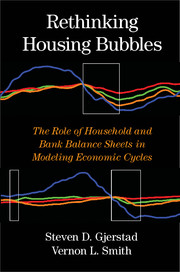 Rethinking Housing Bubbles
Rethinking Housing Bubbles Subprime Mortgages, Derivatives, and Banking Collapse
Published online by Cambridge University Press: 05 June 2014
The parties to these kinds of contract are largely sophisticated financial institutions that would appear to be eminently capable of protecting themselves from fraud and counterparty insolvencies.
– Lawrence Summers, Congressional testimony, July 30, 1998With respect to their safety, derivatives, for the most part, are traded among very sophisticated financial institutions and individuals who have considerable incentive to understand them and to use them properly. The Federal Reserve’s responsibility is to make sure that the institutions it regulates have good systems and good procedures for ensuring that their derivatives portfolios are well managed and do not create excessive risk in their institutions.
– Ben Bernanke, Senate confirmation hearings, November 15, 2005We were on the March 22 call with Fitch regarding the subprime securitization market’s difficulties. My associate asked several questions. “What are the key drivers of your rating model?” They responded, FICO scores and home price appreciation (HPA) of low single digit (LSD) or mid single digit (MSD), as HPA has been for the past fifty years. My associate then asked, “What if HPA was flat for an extended period of time?” They responded that their model would start to break down. He then asked, “What if HPA were to decline 1 percent to 2 percent for an extended period of time?” He then asked, “With 2 percent depreciation, how far up the rating’s scale would it harm?” They responded that it might go as high as the AA or AAA tranches.
– Robert Rodriguez, June 28, 2007Every time there’s been a fire, these guys [derivatives traders] have been around it.
– Nicholas Brady (Lowenstein, 2000, p. 105)The collapse of the housing finance market is in many ways the most fascinating – and certainly the most painful – part of the story of the bubble’s unraveling. In previous chapters, we present a brief primer on the private mortgage market as it developed following the popular initiatives of the Clinton and Bush administrations to expand homeownership and eliminate the capital gains tax (capped at $500,000 for each sale) on homes, the policy actions of government sponsored enterprises (GSE), the continuing large inflows of foreign capital, and the unprecedented (at the time) monetary ease of 2002–2004. The focus now turns to the private housing-mortgage market institutions that served to amplify the housing price run-up, particularly in the period after 2001.
To save this book to your Kindle, first ensure no-reply@cambridge.org is added to your Approved Personal Document E-mail List under your Personal Document Settings on the Manage Your Content and Devices page of your Amazon account. Then enter the ‘name’ part of your Kindle email address below. Find out more about saving to your Kindle.
Note you can select to save to either the @free.kindle.com or @kindle.com variations. ‘@free.kindle.com’ emails are free but can only be saved to your device when it is connected to wi-fi. ‘@kindle.com’ emails can be delivered even when you are not connected to wi-fi, but note that service fees apply.
Find out more about the Kindle Personal Document Service.
To save content items to your account, please confirm that you agree to abide by our usage policies. If this is the first time you use this feature, you will be asked to authorise Cambridge Core to connect with your account. Find out more about saving content to Dropbox.
To save content items to your account, please confirm that you agree to abide by our usage policies. If this is the first time you use this feature, you will be asked to authorise Cambridge Core to connect with your account. Find out more about saving content to Google Drive.